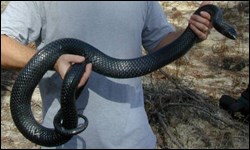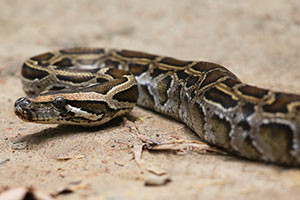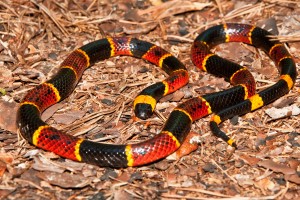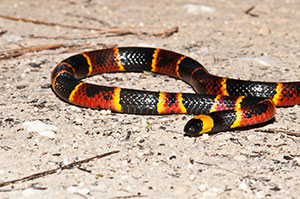 Although the Burmese python is an invasive species threatening the Everglades, the wetland does have several native snakes that DO belong in this habitat. One such snake is the eastern indigo snake (Drymarchon corais couperi). This snake is federally threatened.
Although the Burmese python is an invasive species threatening the Everglades, the wetland does have several native snakes that DO belong in this habitat. One such snake is the eastern indigo snake (Drymarchon corais couperi). This snake is federally threatened.
Eastern indigo snakes are large, black, non-venomous snakes found in the Everglades and other areas in the southeastern United States. It ranges in size from 60 to 84 inches. Sometimes, these snakes will have a little bit of red coloring in their chin, throat, and cheek areas. Like most snakes, they eat fish, frogs, toads, other snakes, lizards, turtles, turtle eggs, small alligators, birds, and small mammals. Young eastern indigo snakes opt to eat invertebrates.
In the Everglades, this species of snake is not found in large numbers. They like to be in flatwoods, pine rocklands, dry prairies, tropical hardwood hammocks, costal dunes, edges of freshwater marshes, agricultural fields, and habitats altered by humans.
The reason this snake is a threatened species is due to a population decline by people domestically and internationally collecting and selling this snake in the pet trade. Also, the snake has been dying off due to rattlesnake collectors who gassed gopher tortoise burrows to collect snakes; however, collecting has declined due to law enforcement. Overall, habitat loss has become one of the snakes biggest threats. With more human development, the mortality rate of this snake increases, because people or domesticated animals are killing the snake, along with it being killed on roads. Pesticides, in areas that humans have developed, have been known to harm this snake, as well.
This snake is active during the day; they prefer wetter areas in the summer and drier areas in the winter.
When threatened, the eastern indigo snake have been known to flatten their heads, hiss, and rattle their tails. However, they are not known to be biters.
It is believed any additional threats to this snake will cause it to begin to disappear from certain areas. It’s predicted that there will be many isolated, small groups of the eastern indigo snake, which will make it hard for this snake to reproduce and grow into bigger populations.
Since the Everglades is preserved land and is continued to be a restored environment, the eastern indigo snake has a safer habitat to thrive in.
Want to try and spot the threatened snake on your next trip to the Everglades? You might be able to see one while aboard an airboat. Airboats brings you around areas of the Everglades that you cannot get to by foot. Join Captain Mitch’s Airboat Tours for a fun time. To book a airboat ride, click here or call 800-368-0065.
 One of the biggest threats to a balanced ecosystem in the Everglades is the Burmese pythons. These snakes are an invasive species in the wetland. The python happens to love the Everglades, but this wetland cannot handle its presence. Pythons prey on almost anything in their path, and have been known to cause a large depletion in the rabbit, opossum, wading birds, racoons and other small populations population in the area. Its only predators are the American alligator and the Florida panther. However, these pythons can put up a fight and a recent video take by someone in the Everglades showed an alligator losing a fight with a python in water.
One of the biggest threats to a balanced ecosystem in the Everglades is the Burmese pythons. These snakes are an invasive species in the wetland. The python happens to love the Everglades, but this wetland cannot handle its presence. Pythons prey on almost anything in their path, and have been known to cause a large depletion in the rabbit, opossum, wading birds, racoons and other small populations population in the area. Its only predators are the American alligator and the Florida panther. However, these pythons can put up a fight and a recent video take by someone in the Everglades showed an alligator losing a fight with a python in water. Twenty three snake species live in the Everglades. Of these 23, only four are venomous. Many people have a fear of snakes, and with several being poisonous, it makes sense why people prefer to stay away from these slithering creatures. However, these reptiles are an important part of the ecosystem of the Everglades. They control and prey on the number of rodents, invertebrates and other snakes. These snakes are also a food source for birds and alligators.
Twenty three snake species live in the Everglades. Of these 23, only four are venomous. Many people have a fear of snakes, and with several being poisonous, it makes sense why people prefer to stay away from these slithering creatures. However, these reptiles are an important part of the ecosystem of the Everglades. They control and prey on the number of rodents, invertebrates and other snakes. These snakes are also a food source for birds and alligators.






